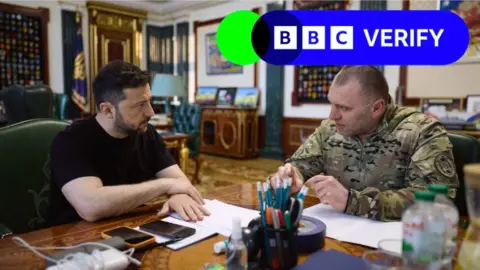On June 1, 2025, Ukraine executed a groundbreaking military operation, dubbed “Spider Web”, involving over 100 drones that targeted multiple air bases across Russia. This meticulously planned assault not only displayed remarkable ingenuity but also took 18 months to prepare. The operation’s sheer scale was astonishing, with reports of explosions felt across vast regions, from Murmansk in the Arctic Circle to the Amur region, located over 8,000 kilometers from Ukraine.
Early reports indicated the effectiveness of the attack, with the Russian Defense Ministry confirming strikes in five distinct regions: Murmansk, Irkutsk, Ivanovo, Ryazan, and Amur. However, the damage was reportedly limited to Murmansk and Irkutsk, where some planes were reported damaged. Ukrainian officials shared images of Vasyl Maliuk, the head of the Security Service of Ukraine (SBU), examining satellite maps showcasing the identified bases that had been struck.
Vasyl Maliuk explained how the drones were smuggled into Russia, ingeniously concealed within wooden cabins on the back of trucks that had detachable roofs. These vehicles were presumably operated by unwitting drivers, who were in the dark about their cargo. After being parked near the airbases, the drones were launched towards their targets, with videos surfacing of drones emerging from a truck’s roof. A lorry driver recounted their experience of trying to thwart the drones’ launch by throwing stones at them.
Reports suggest that these drivers had been hired by businessmen to transport cabins across various locations in Russia, emphasizing the intricacy of the operation. Following the drone launches, Ukrainian President Volodymyr Zelensky took to social media, announcing the use of 117 drones in an attack that had taken “one year, six months, and nine days” to plan. Furthermore, Zelensky noted that one of the targeted locations was alarmingly close to offices of the FSB, Russia’s security services.
In response to the operation, Russian authorities began making arrests linked to the drone attack, though Zelensky indicated that those who assisted in the operation had already been evacuated from Russian territory and were safe. One local authority in Irkutsk even reported looking for a 37-year-old man of Ukrainian descent in connection with an attack targeting the Belaya military airfield.
The drones employed in the operation were described as simple quadrupeds capable of carrying heavy payloads. Dr. Steve Wright, a drone expert, highlighted the extraordinary aspect of this mission: the drones’ covert entry into Russia and remote command capabilities, likely facilitated via satellite or internet links. Each of the 117 drones reportedly had a dedicated pilot guiding it toward its target.
In terms of impact, Zelensky stated that Russia suffered quantifiable losses as a result of the attack, with Ukrainian sources claiming that 41 strategic bombers were damaged, with at least 13 of those entirely destroyed. While Russia has yet to confirm these losses, they acknowledged some damage to their aircraft. Video evidence has surfaced showing significant damage at Olenegorsk air base in Murmansk and Belaya air base in Irkutsk.
The strategic bombers targeted included the Tu-95, Tu-22, and Tu-160, aircraft critical to Russia’s military capabilities, particularly in missile attacks on Ukraine. With recent intelligence suggesting that these bombers were involved in launching Kh-101 missiles against Ukraine, the attack poses a severe blow to their operational capabilities, as replacements for these types of bombers are not realistically feasible.
The broader implications of the “Spider Web” operation were profound, costing Russia an estimated $7 billion. Russian state media’s lack of reporting on the incident starkly contrasts with the celebratory reactions among Ukrainians, highlighting the operation’s significance. Zelensky emphasized its importance, noting that the actions taken would be remembered in history, suggesting an ongoing evolution in the dynamics of the conflict between Ukraine and Russia.



